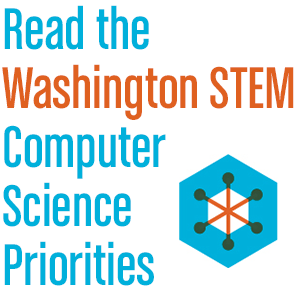WASHINGTON COMPUTER SCIENCE STANDARDS – WHAT ARE THEY?
It’s no secret that computer science jobs in Washington are some of the highest paid but often go unfilled due to the lack of qualified applicants. There’s certainly many reasons for this jobs gap, but most often cited is there simply are not enough people with the education to fill those jobs. At Washington STEM, we’re committed to making sure that that trend turns around.
For the past five years, we’ve been advocating to the Washington Legislature to create the framework and funding necessary to provide a high-quality computer science education. Along with key partners like code.org, we’ve helped ensure that access to computer science education expands across Washington and that students can take AP Computer Science and have it count towards their graduation credits. But really, that’s just the start.

The Office of the Superintendent of Public Instruction’s (OSPI) vision is that “every student is ready for college, career, and life.” And they believe, as does Washington STEM, that effective and relevant computer science education is essential to achieving those aims. To equip all students in Washington with the ability to take on computer science curriculum, we must have an equitable starting point. That’s where the Washington State Computer Science K-12 Learning Standards come in. In December of 2016, then State Superintendent Randy Dorn of OSPI, with new Superintendent Chris Reykdal at his side, adopted the state computer science standards. The Standards lay out a series of outcomes for Washington’s students with learning standards of equity, access, inclusion, and diversity at the forefront.
Equity, access, inclusion, and diversity are included to make sure that students of all backgrounds, including women, underrepresented minorities, students with disabilities, and those limited by geography or economic status can take full advantage of the opportunities that computer science can provide. As we rapidly accelerate towards a world that is connected and influenced by technology, students need to be equipped with the knowledge to understand and thrive in that world. Washington’s students should not just be consumers of technology but the producers and creators of the next generation of innovation.
As written in the standards themselves, “The standards are meant to establish a baseline literacy in computer science for all students and provide guidance for designing curriculum, assessments, and teacher preparation programs. It consists of five core concepts and seven core practices.”
Core Concepts
- Computing Systems
- Networks and the Internet
- Data and Analysis
- Algorithms and Programming
- Impacts of Computing
Core Practices
- Fostering an Inclusive and Diverse Computing Culture
- Collaborating
- Recognizing and Defining Computational Problems
- Developing and Using Abstractions
- Creating Computational Artifacts
- Testing and Refining
- Communicating
If you are wondering what the curriculum looks like or what tests are going to look like, those are intentionally left out of the computer science standards. The standards exist to provide a framework for practitioners to reference as they design curriculum and testing around computer science. As with all of Washington’s learning standards, they are written in a way that allows local-decision making. There’s no top down organization telling a teacher how she has to teach. Instead, school districts have a pathway to guide them as they make decisions and design curriculum that are appropriate for their districts, communities, and classrooms. The standards help define what is important for students to know and be able to do as they progress through school.
The computer science standards were written by a consortium of teachers, administrators, subject matter experts, state and national associations, and stakeholders in computer science. Collaborators from across Washington came together to create these standards to make sure all of Washington’s school districts can benefit from these standards. By committing to these standards, Washington has committed to providing its students with yet another avenue to explore, learn, and prepare themselves for the jobs of tomorrow.
We view computer science as critical for every student in this state. But again, this is only the beginning. To continue the momentum of computer science in the state, we have to make sure that computer science is fully funded. We have the tools and the pathway. We just have to commit to allocating the resources to ensure that every single student in Washington has access to a high-quality computer science education.
Currently, the Washington state legislature is working on the 2018-2020 budget, and we urge you to join us as we continue to make the push for STEM and computer science in Washington’s public schools.
To take a closer look at the core concepts and practices and find more in-depth information, you can read the Washington State Computer Science K-12 Learning Standards here: http://www.k12.wa.us/ComputerScience/pubdocs/ComputerScienceK-12LearningStandards2016.pdf